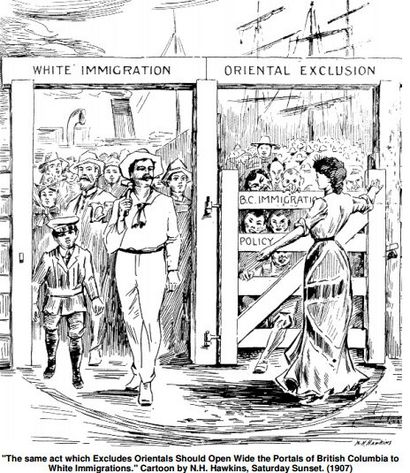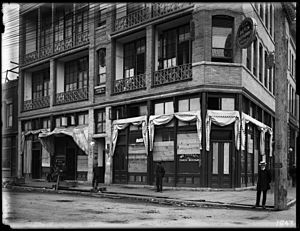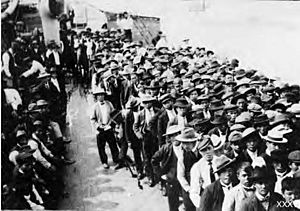Anti-Oriental riots (Vancouver) facts for kids
Quick facts for kids Vancouver anti-Asian riots |
|||
|---|---|---|---|
| Part of the Pacific Coast race riots of 1907 | |||

Exclusionist cartoon in Saturday Sunset magazine by N.H. Hawkins, Vancouver, 24 August 1907
|
|||
| Date | September 7–9, 1907 | ||
| Location | |||
| Caused by | anti-immigration sentiment | ||
| Parties to the civil conflict | |||
|
|||
| Casualties | |||
| Death(s) | none confirmed | ||
| Injuries | unknown | ||
| Arrested | At least 19 | ||
| Fined | ~$36,420 indemnities | ||
The Vancouver riots happened from September 7 to 9, 1907, in Vancouver, British Columbia, Canada. Around the same time, similar anti-Asian riots took place in other cities on the West Coast, like San Francisco and Bellingham, Washington. These events weren't planned together. Instead, they showed a common feeling against immigrants. Groups like labour unions and small businesses encouraged these actions. No one was killed, but Asian-owned businesses and homes were badly damaged. After the riots, China and Canada made an informal agreement to stop Chinese people from moving to Canada.
Contents
Why the Riots Happened
In the early 1900s, relations between different racial groups were tense in Canada's Pacific Coast region. Many Chinese immigrants had come to Canada to help build the railways. Japanese immigrants came to fish, and South Asian immigrants came to farm and work in logging.
By 1901, about 16,000 Chinese immigrants lived in British Columbia. This number had grown from earlier years. There were also about 8,000 Japanese and 5,000 South Asian immigrants.
More ships kept arriving with new immigrants. For example, the SS Kumeric brought 1,177 Japanese people in 1907. The SS Tartar brought 514 Indian people in 1907. At the same time, a financial crisis called the Panic of 1907 made it hard to find jobs. This made the racial tensions even worse.
Many white people felt that Asian immigrants were "taking their jobs." Countries like Australia had already stopped most Asian immigration. In Canada, a group called the Asiatic Exclusion League wanted Canada to do the same.
The riots on September 7, 1907, were the result of growing anger towards Asian immigrants. By October 1907, over 11,000 new Asian immigrants had arrived that year. As these numbers grew, anti-Asian groups worried that Japanese people might gain too much control in Vancouver. The riots were a way for these groups to show how strongly they felt against Asian immigration. They hoped to convince the government to stop it.
What Happened During the Riots
The 1907 Vancouver riot was not the first time anti-Asian violence happened in Vancouver. An earlier incident took place in 1887. The events in Vancouver were partly sparked by a riot in Bellingham, Washington, on September 5, 1907. That riot targeted East Indian lumber workers. Many Chinese people who were victims in Bellingham fled to Canada. This made the Asiatic Exclusion League in Vancouver even more determined to act against Asian immigration.
Leading Up to the Riot
Earlier in 1907, a railway company wanted to bring 10,000 Japanese workers to build a new railway line. The Premier of British Columbia did not like this idea because it was such a large number.
On August 12, 1907, members of the Asiatic Exclusion League met. They asked the Canadian government to enforce a new law that would limit immigration. However, the Canadian government refused to support this law.
The Parade and Attack
At a third meeting, the Asiatic Exclusion League decided to hold a parade on Saturday, September 7. They planned to have a band to attract attention. The parade would end at Vancouver City Hall, which was next to Chinatown. A rally would be held there to talk about Asian immigration. About 10,000 Canadian and American citizens marched in this anti-Asian immigration parade.

During the rally, someone threw a rock, breaking a window. This started a much larger riot in Vancouver. The crowd from the parade turned into an angry mob. They threw bottles and rocks at windows, trying to destroy Chinese-owned stores and homes. Most of the buildings attacked were actually owned by white people who rented them to Chinese businesses.
After damaging Chinese businesses, the mob moved to Japantown. Japanese residents fought back, but more than 50 stores and businesses on Powell Street had their windows broken. This caused thousands of dollars in damage. The riot finally ended around 3 AM on September 8. By dawn, the city was quiet.
What Happened After
The government sent Labour Minister MacKenzie King to investigate the events. He also arranged for $36,000 to be paid to the Japanese-Canadian community for the damages.
The Vancouver riot led to new rules for Japanese immigration. This was called the gentlemen's agreement and started in Canada on January 25, 1908. In this agreement, Japan agreed to limit the number of passports given to male labourers and domestic servants to a maximum of 400 per year. Canada also passed a "Continuous journey" law. This law said immigrants had to travel directly from their home country to Canada.
The attacks in Vancouver were even discussed by the German Emperor Wilhelm II in 1908. He warned about a "Yellow Peril," which was a racist idea that Asian people were a threat to Western countries. He used the Vancouver attacks as an example of problems in British foreign policy.
Even though South Asian people were mostly safe during the riots, they were still affected. In 1908, the British Columbia government passed a law stopping South Asian men from voting. Because federal election rules were based on provincial voting lists, they couldn't vote in federal elections either. The Canadian government also added a $200 head tax on Indian immigrants. They also had to follow the "continuous journey" rule, but there were no direct boats from India to Canada. After 1908, very few South Asian immigrants came to Canada until the 1940s. These strict rules later led to the famous Komagata Maru Incident in 1914.


